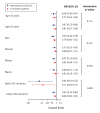Usefulness of Maintaining a Normal Electrocardiogram Over Time for Predicting Cardiovascular Health
- PMID: 28126148
- PMCID: PMC5283845
- DOI: 10.1016/j.amjcard.2016.09.051
Usefulness of Maintaining a Normal Electrocardiogram Over Time for Predicting Cardiovascular Health
Abstract
We hypothesized that maintaining a normal electrocardiogram (ECG) status over time is associated with low cardiovascular (CV) disease in a dose-response fashion and subsequently could be used to monitor programs aimed at promoting CV health. This analysis included 4,856 CV disease-free participants from the Atherosclerosis Risk in Communities study who had a normal ECG at baseline (1987 to 1989) and complete electrocardiographic data in subsequent 3 visits (1990 to 1992, 1993 to 1995, and 1996 to 1998). Participants were classified based on maintaining their normal ECG status during these 4 visits into "maintained," "not maintained," or "inconsistent" normal ECG status as defined by the Minnesota ECG classification. CV disease events (coronary heart disease, heart failure, and stroke) were adjudicated from Atherosclerosis Risk in Communities visit-4 through 2010. Over a median follow-up of 13.2 years, 885 CV disease events occurred. The incidence rate of CV disease events was lowest among study participants who maintained a normal ECG status, followed by those with an inconsistent pattern, and then those who did not maintain their normal ECG status (trend p value <0.001). Similarly, the greater the number of visits with a normal ECG status, the lower was the incidence rate of CV disease events (trend p value <0.001). Maintaining (vs not maintaining) a normal ECG status was associated with a lower risk of CV disease, which was lower than that observed in those with inconsistent normal ECG pattern (trend p value <0.01). In conclusion, maintaining a normal ECG status over time is associated with low risk of CV disease in a dose-response fashion, suggesting its potential use as a monitoring tool for programs promoting CV health.
Copyright © 2016 Elsevier Inc. All rights reserved.
Conflict of interest statement
None.
Figures




Similar articles
-
Electrocardiography score based on the Minnesota code classification system predicts cardiovascular mortality in an asymptomatic low-risk population.Ann Med. 2023;55(2):2288306. doi: 10.1080/07853890.2023.2288306. Epub 2023 Dec 5. Ann Med. 2023. PMID: 38052061 Free PMC article.
-
Prevalence and prognostic impact of electrocardiographic abnormalities in outpatients with extracardiac artery disease.Clin Physiol Funct Imaging. 2018 Sep;38(5):823-829. doi: 10.1111/cpf.12488. Epub 2017 Nov 24. Clin Physiol Funct Imaging. 2018. PMID: 29171136
-
Predictors of electrocardiographic abnormalities in type 1 Diabetes: the Wisconsin Epidemiologic Study of Diabetic Retinopathy.J Endocrinol Invest. 2017 Mar;40(3):313-318. doi: 10.1007/s40618-016-0564-z. Epub 2016 Oct 20. J Endocrinol Invest. 2017. PMID: 27766550 Free PMC article.
-
Regression of electrocardiographic left ventricular hypertrophy or strain is associated with lower incidence of cardiovascular morbidity and mortality in hypertensive patients independent of blood pressure reduction - A LIFE review.J Electrocardiol. 2014 Sep-Oct;47(5):630-5. doi: 10.1016/j.jelectrocard.2014.07.003. Epub 2014 Jul 3. J Electrocardiol. 2014. PMID: 25052475 Review.
-
The ageing athlete: screening prior to vigorous exertion in asymptomatic adults without known cardiovascular disease.Br J Sports Med. 2009 Sep;43(9):696-701. doi: 10.1136/bjsm.2008.054783. Br J Sports Med. 2009. PMID: 19734505 Review.
Cited by
-
Deep neural network-estimated electrocardiographic age as a mortality predictor.Nat Commun. 2021 Aug 25;12(1):5117. doi: 10.1038/s41467-021-25351-7. Nat Commun. 2021. PMID: 34433816 Free PMC article.
-
Global ECG Measures and Cardiac Structure and Function: The ARIC Study (Atherosclerosis Risk in Communities).Circ Arrhythm Electrophysiol. 2018 Mar;11(3):e005961. doi: 10.1161/CIRCEP.117.005961. Circ Arrhythm Electrophysiol. 2018. PMID: 29496680 Free PMC article.
-
Evaluating the association of ischemic ECG changes and CBC parameters in normal population.ARYA Atheroscler. 2025;21(4):15-25. doi: 10.48305/arya.2025.43555.3038. ARYA Atheroscler. 2025. PMID: 40893715 Free PMC article.
-
Major and minor ECG abnormalities depending on regional living conditions in Russia.Sci Rep. 2023 Jun 1;13(1):8934. doi: 10.1038/s41598-023-35947-2. Sci Rep. 2023. PMID: 37264214 Free PMC article.
-
Association of major and minor ECG abnormalities with traditional cardiovascular risk factors in the general population: a large scale study.Sci Rep. 2024 May 17;14(1):11289. doi: 10.1038/s41598-024-62142-8. Sci Rep. 2024. PMID: 38760424 Free PMC article.
References
-
- Chou R, Arora B, Tracy D, Fu R, Walker M, Humphrey L. Screening asymptomatic adults with resting or exercise electrocardiography: a review of the evidence for the U.S. Preventive Services Task Force. Ann Intern Med. 2011;155:375–385. - PubMed
-
- Denes P, Larson JC, Lloyd-Jones DM, Prineas RJ, Greenland P. Major and minor ECG abnormalities in asymptomatic women and risk of cardiovascular events and mortality. JAMA. 2007;297:978–985. - PubMed
-
- Denes P, Lloyd-Jones D, Garside DB, Gouskova N, Soliman EZ, Ostfeld R, Zhang ZM, Camacho A, Prineas R, Raij L, Daviglus ML. Major and minor electrocardiogram abnormalities and their association with underlying cardiovascular disease and risk factors in Hispanics/Latinos (From the Hispanic Community Health Study/Study of Latinos [HCHS/SOL]) Am J Cardiol. 2013;112:1667–1675. - PMC - PubMed
-
- Soliman EZ, Prineas RJ, Boccara F, Duprez D, Roediger M, Stein J, Lundgren J, Boesecke C, Stephan C, Hodder S, Neaton J. Prevalence and prognostic significance of ECG abnormalities in HIV-infected patients: Results from The Strategies for Management of Antiretroviral Therapy (SMART) trial. J Electrocardiol. 2011;44:779–785. - PMC - PubMed
Publication types
MeSH terms
Grants and funding
- HHSN268201100012C/HL/NHLBI NIH HHS/United States
- HHSN268201100009I/HL/NHLBI NIH HHS/United States
- HHSN268201100010C/HL/NHLBI NIH HHS/United States
- HHSN268201100008C/HL/NHLBI NIH HHS/United States
- HHSN268201100005G/HL/NHLBI NIH HHS/United States
- HHSN268201100008I/HL/NHLBI NIH HHS/United States
- HHSN268201100007C/HL/NHLBI NIH HHS/United States
- HHSN268201100011I/HL/NHLBI NIH HHS/United States
- HHSN268201100011C/HL/NHLBI NIH HHS/United States
- HHSN268201100006C/HL/NHLBI NIH HHS/United States
- R01 HL118277/HL/NHLBI NIH HHS/United States
- HHSN268201100005I/HL/NHLBI NIH HHS/United States
- HHSN268201100009C/HL/NHLBI NIH HHS/United States
- HHSN268201100005C/HL/NHLBI NIH HHS/United States
- HHSN268201100007I/HL/NHLBI NIH HHS/United States
LinkOut - more resources
Full Text Sources
Other Literature Sources

